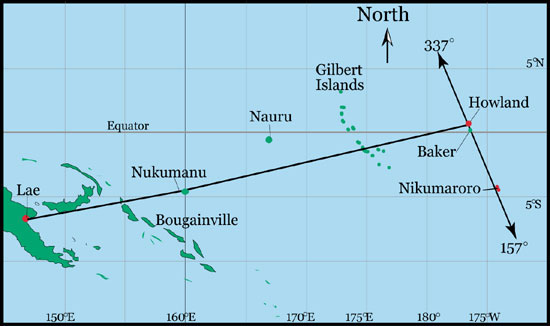|
Roughly twenty
hours into the flight, and with somewhere between three and four
hours of fuel remaining, Earhart and Noonan have been unable to
make visual or two-way radio contact with Howland Island. They implement
the only procedure available to them which will minimize the chance
of having to land the aircraft in the sea: they proceed southeastward
on a course of 157 degrees. Go there.
Shortly before
noon, the aircraft is landed successfully on the reef-flat at Gardner
Island at or near low tide on the smooth stretch of coral just north
of the S.S. Norwich City, the ship that ran aground there
in 1929. Go there.
That evening,
the aircraft’s radio is used to send distress calls. Go
there.
By a week later,
rougher seas and increased surf on the reef have forced Earhart
and Noonan to abandon the aircraft which is now obscured from view
at high tide. The castaways seek shelter from the sun in the dense
bush inland and come upon a cache of provisions left behind by the
rescuers of the Norwich City survivors eight years earlier.
When search planes from the USS Colorado are heard overhead
on the morning of July 9th, Earhart and Noonan are unable to reach
the open beach in time to be seen. If anything of the airplane was
visible through the surf, its proximity to the Norwich City
leads the searchers to dismiss it as debris from the shipwreck.
Go there.
Literally
marooned on a desert island, Earhart and Noonan survive for a time
but eventually succumb to any of a number of possible causes including
injury and infection, food poisoning (some local fish are highly
toxic), or simply thirst. Earhart dies at a small makeshift campsite
on the island’s southeastern side. Noonan’s fate is less clear.
Go there.
The airplane
on the reef is destroyed by surf action and the debris is scattered
“downstream” across the reef-flat, along the shoreline, and into
the lagoon. During the island’s period of habitation (1938–1963)
the colonists encounter, and in some cases recover and use, various
bits of wreckage. Those components recovered by the colonists are
mostly consumed in local uses such as fishing tackle and decorative
items. Go there.
Little of
NR16020 may now survive. Some wreckage may have been pulled seaward
from the original landing site and may rest in deep water offshore.
The apparent absence of wreckage in the shoreline vegetation at
the west end of the island (as indicated by TIGHAR’s 1999 search)
is probably due to earlier salvage activity by the colonists and
the scouring action of significant weather events in subsequent
years. Buoyant bits of wreckage may have washed up anywhere along
the lagoon shore and may still survive deep in the dense shoreline
vegetation. More scraps of salvaged material used by the islanders
almost certainly survive in the abandoned and overgrown village.
The portions of Earhart’s skeleton not found in 1940 (primarily
the spine, ribs, half of the pelvis, hands and feet, one arm, and
one lower leg) may still survive, scattered in the bush. The bones
that were recovered and examined may still exist but search efforts
to date have been unsuccessful. Go there.
|

